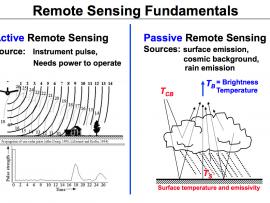Browse 6 - 8 Resources
Browse 6 - 8 Resources
Primary Topic:
Subtopics:
Type:
Keywords:
Summary:
This diagram illustrates the differences between active and passive remote sensing. TRMM and GPM rely on active and passive instruments to measure the properties of precipitation from space.
Primary Topic:
Subtopics:
Type:
Keywords:
Summary:
During the 2010 hurricane season, NASA deployed its piloted DC-8 and WB-57, and unmanned Global Hawk aircraft, arming hurricane researchers with the information needed to predict the growth and intensification of hurricanes.
Primary Topic:
Subtopics:
Type:
Keywords:
Summary:
NASA will dispatch two unmanned aircraft equipped with specialized instruments high above tropical cyclones in the Atlantic Ocean basin. These "severe storm sentinels" will investigate the processes that underlie hurricane formation and intensity change.
Primary Topic:
Subtopics:
Type:
Keywords:
Summary:
Learn about the life cycle of a satellite at Goddard Space Flight Center. This interactive 'tour' starts with the Idea phase and goes through the whole process ofa NASA satellite mission. This tour is an interesting introduction to the engineering process
Primary Topic:
Subtopics:
Type:
Keywords:
Summary:
View recent data for air temperature, carbon dioxide, carbon monoxide, sea level, ozone, ice and water using an interactive viewer. You can also follow NASA's satellites and learn how they collect critical data about Earth's atmosphere, land, and oceans.
Primary Topic:
Subtopics:
Type:
Keywords:
Summary:
A basic introduction to meteorology, including inquiry activities and instructions to build and use weather instruments for a weather station, collect data, and predict weather systems.
Primary Topic:
Subtopics:
Type:
Keywords:
Summary:
The cryosphere consists of those parts of the Earth's surface where water is found in solid form, including areas of snow, sea ice, glaciers, permafrost, ice sheets, and icebergs. This animation shows fluctuations in the cryosphere.
Primary Topic:
Subtopics:
Type:
Keywords:
Summary:
Learn about precipitation and how clouds are formed. Find out why scientists study clouds and how you can help NASA collect cloud observation data as part of the Students' Cloud Observation OnLine, or S'COOL, Project.
Primary Topic:
Subtopics:
Type:
Keywords:
Standards:
Summary:
An educational outreach program allowing middle school students to take pictures of our Earth from a digital camera on board the International Space Station. Educators must register in order to participate in EarthKAM missions and request photos of Earth.
Primary Topic:
Subtopics:
Type:
Keywords:
Summary:
This video covers the impact that climate change is having on Earth's oceans, and shows how technology is being used by NASA to help us learn how oceans are responding to climate change.











